HMG7230 - Analyzing Sudan's Food System: Resilience and Policy Support
VerifiedAdded on 2022/09/30
|13
|3860
|340
Report
AI Summary
This report provides a comprehensive analysis of Sudan's food system, highlighting its vulnerabilities to shocks such as climate change, conflict, and poverty. It examines food utilization, consumption patterns, and access to food both internally and externally, detailing the country's reliance on agriculture, livestock rearing, and food imports. The report also explores the availability of food, including domestic production and external sources, and assesses the supporting resources, services, policies, and organizations that contribute to food security. Furthermore, it identifies actions to improve the resilience of the food system, emphasizing the need for risk management policies, improved governance, and sustainable resource management. The analysis underscores the challenges posed by climate change, conflicts, and economic instability, offering recommendations to strengthen food security and resilience in Sudan, which can be found with other study resources on Desklib.
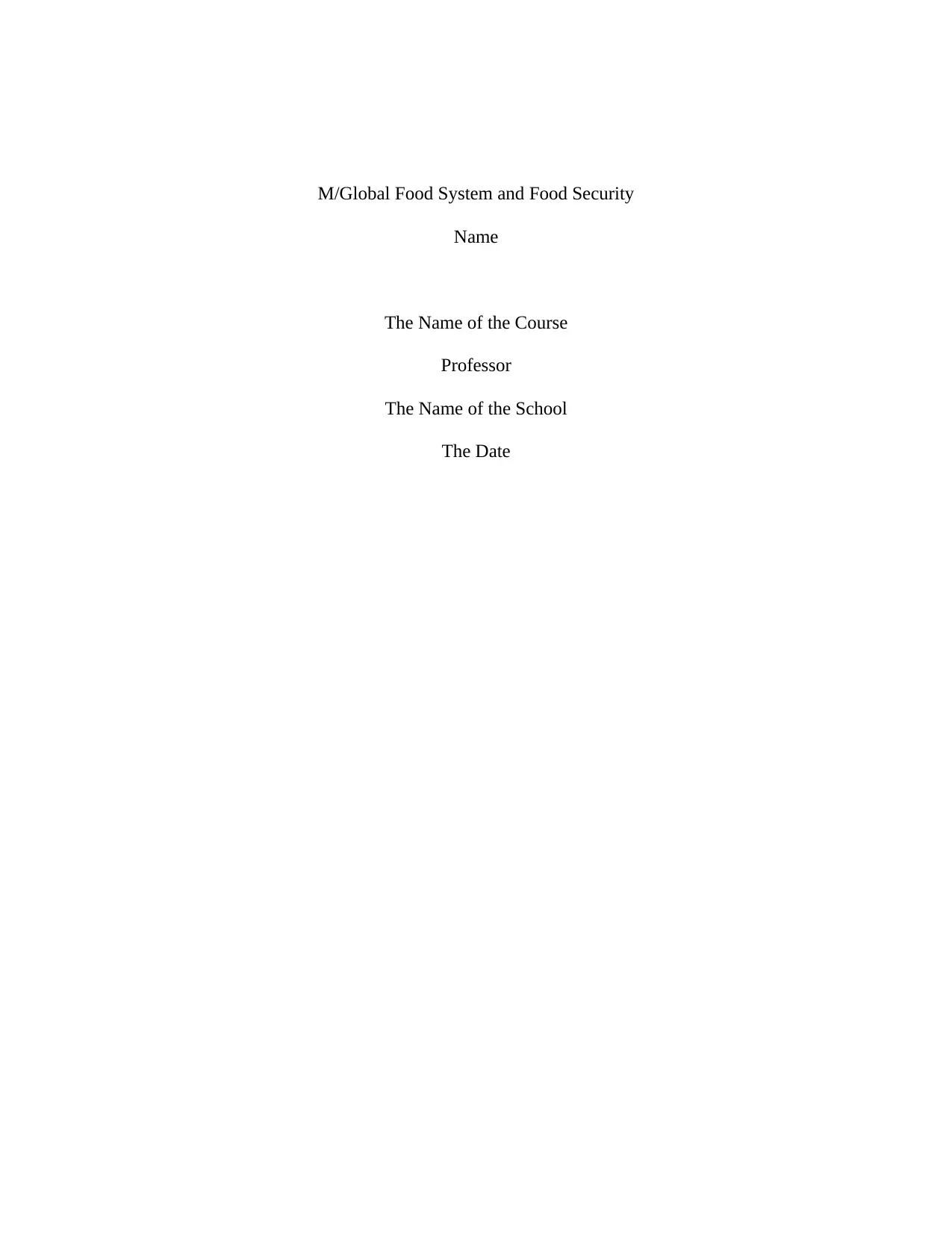
M/Global Food System and Food Security
Name
The Name of the Course
Professor
The Name of the School
The Date
Name
The Name of the Course
Professor
The Name of the School
The Date
Paraphrase This Document
Need a fresh take? Get an instant paraphrase of this document with our AI Paraphraser
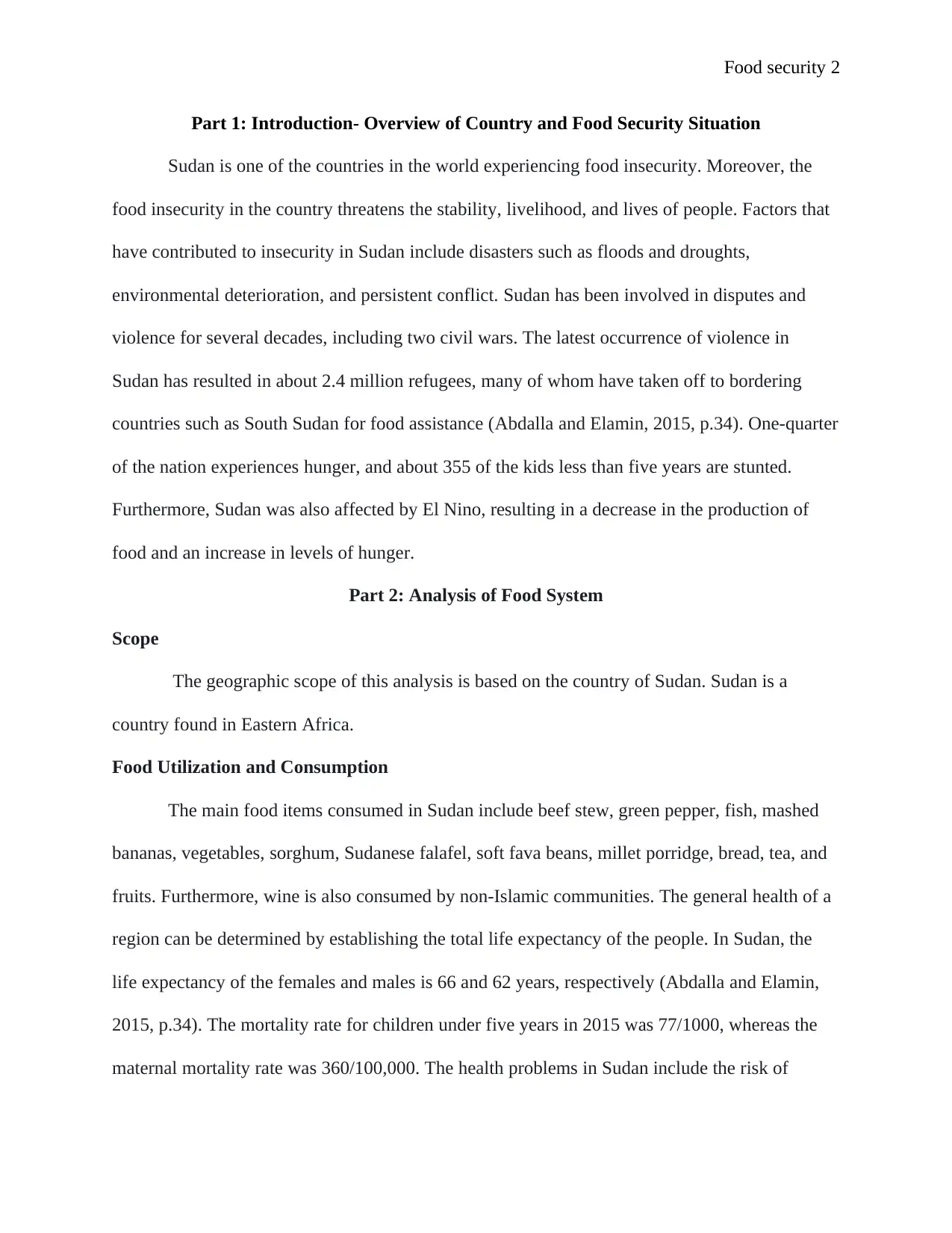
Food security 2
Part 1: Introduction- Overview of Country and Food Security Situation
Sudan is one of the countries in the world experiencing food insecurity. Moreover, the
food insecurity in the country threatens the stability, livelihood, and lives of people. Factors that
have contributed to insecurity in Sudan include disasters such as floods and droughts,
environmental deterioration, and persistent conflict. Sudan has been involved in disputes and
violence for several decades, including two civil wars. The latest occurrence of violence in
Sudan has resulted in about 2.4 million refugees, many of whom have taken off to bordering
countries such as South Sudan for food assistance (Abdalla and Elamin, 2015, p.34). One-quarter
of the nation experiences hunger, and about 355 of the kids less than five years are stunted.
Furthermore, Sudan was also affected by El Nino, resulting in a decrease in the production of
food and an increase in levels of hunger.
Part 2: Analysis of Food System
Scope
The geographic scope of this analysis is based on the country of Sudan. Sudan is a
country found in Eastern Africa.
Food Utilization and Consumption
The main food items consumed in Sudan include beef stew, green pepper, fish, mashed
bananas, vegetables, sorghum, Sudanese falafel, soft fava beans, millet porridge, bread, tea, and
fruits. Furthermore, wine is also consumed by non-Islamic communities. The general health of a
region can be determined by establishing the total life expectancy of the people. In Sudan, the
life expectancy of the females and males is 66 and 62 years, respectively (Abdalla and Elamin,
2015, p.34). The mortality rate for children under five years in 2015 was 77/1000, whereas the
maternal mortality rate was 360/100,000. The health problems in Sudan include the risk of
Part 1: Introduction- Overview of Country and Food Security Situation
Sudan is one of the countries in the world experiencing food insecurity. Moreover, the
food insecurity in the country threatens the stability, livelihood, and lives of people. Factors that
have contributed to insecurity in Sudan include disasters such as floods and droughts,
environmental deterioration, and persistent conflict. Sudan has been involved in disputes and
violence for several decades, including two civil wars. The latest occurrence of violence in
Sudan has resulted in about 2.4 million refugees, many of whom have taken off to bordering
countries such as South Sudan for food assistance (Abdalla and Elamin, 2015, p.34). One-quarter
of the nation experiences hunger, and about 355 of the kids less than five years are stunted.
Furthermore, Sudan was also affected by El Nino, resulting in a decrease in the production of
food and an increase in levels of hunger.
Part 2: Analysis of Food System
Scope
The geographic scope of this analysis is based on the country of Sudan. Sudan is a
country found in Eastern Africa.
Food Utilization and Consumption
The main food items consumed in Sudan include beef stew, green pepper, fish, mashed
bananas, vegetables, sorghum, Sudanese falafel, soft fava beans, millet porridge, bread, tea, and
fruits. Furthermore, wine is also consumed by non-Islamic communities. The general health of a
region can be determined by establishing the total life expectancy of the people. In Sudan, the
life expectancy of the females and males is 66 and 62 years, respectively (Abdalla and Elamin,
2015, p.34). The mortality rate for children under five years in 2015 was 77/1000, whereas the
maternal mortality rate was 360/100,000. The health problems in Sudan include the risk of
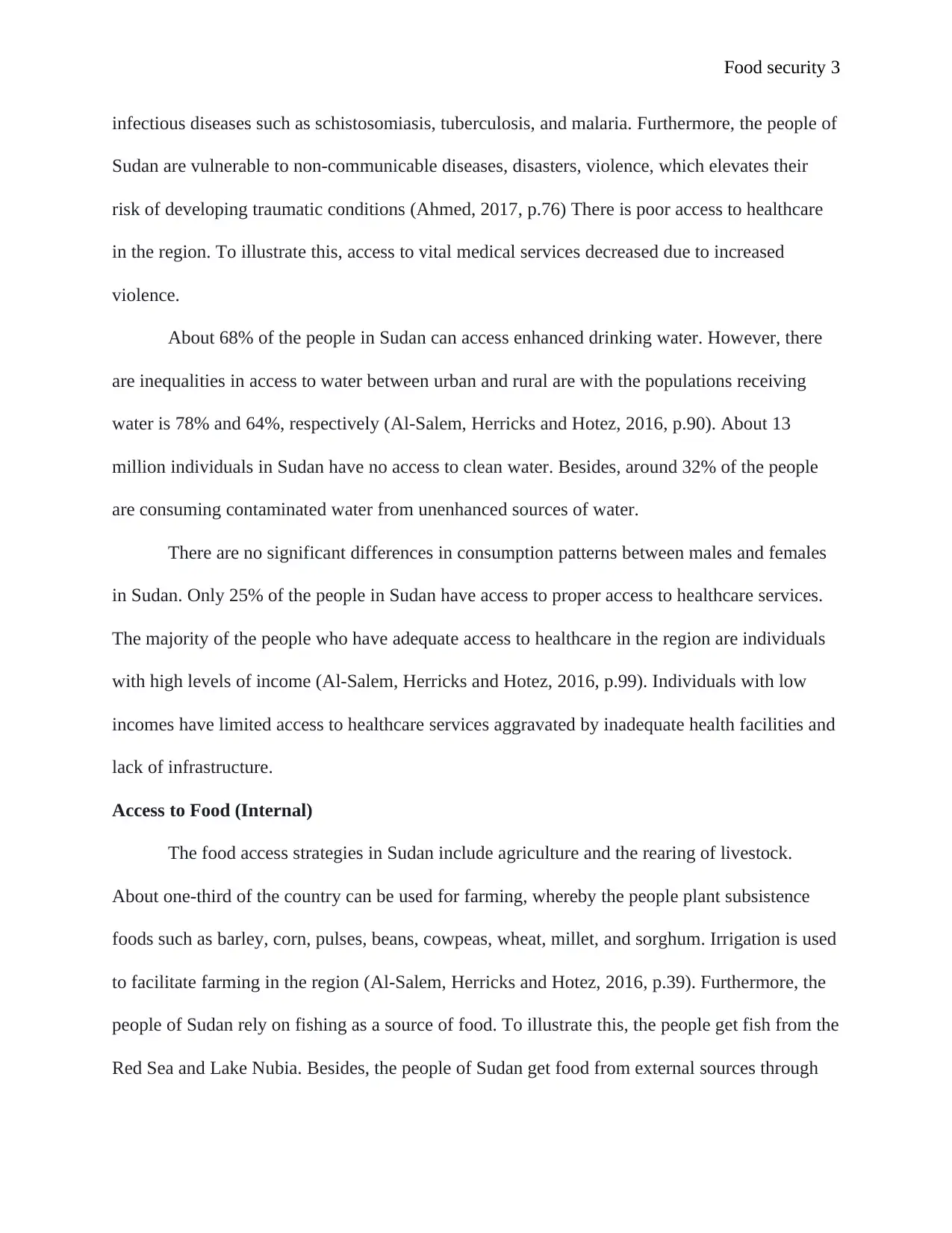
Food security 3
infectious diseases such as schistosomiasis, tuberculosis, and malaria. Furthermore, the people of
Sudan are vulnerable to non-communicable diseases, disasters, violence, which elevates their
risk of developing traumatic conditions (Ahmed, 2017, p.76) There is poor access to healthcare
in the region. To illustrate this, access to vital medical services decreased due to increased
violence.
About 68% of the people in Sudan can access enhanced drinking water. However, there
are inequalities in access to water between urban and rural are with the populations receiving
water is 78% and 64%, respectively (Al-Salem, Herricks and Hotez, 2016, p.90). About 13
million individuals in Sudan have no access to clean water. Besides, around 32% of the people
are consuming contaminated water from unenhanced sources of water.
There are no significant differences in consumption patterns between males and females
in Sudan. Only 25% of the people in Sudan have access to proper access to healthcare services.
The majority of the people who have adequate access to healthcare in the region are individuals
with high levels of income (Al-Salem, Herricks and Hotez, 2016, p.99). Individuals with low
incomes have limited access to healthcare services aggravated by inadequate health facilities and
lack of infrastructure.
Access to Food (Internal)
The food access strategies in Sudan include agriculture and the rearing of livestock.
About one-third of the country can be used for farming, whereby the people plant subsistence
foods such as barley, corn, pulses, beans, cowpeas, wheat, millet, and sorghum. Irrigation is used
to facilitate farming in the region (Al-Salem, Herricks and Hotez, 2016, p.39). Furthermore, the
people of Sudan rely on fishing as a source of food. To illustrate this, the people get fish from the
Red Sea and Lake Nubia. Besides, the people of Sudan get food from external sources through
infectious diseases such as schistosomiasis, tuberculosis, and malaria. Furthermore, the people of
Sudan are vulnerable to non-communicable diseases, disasters, violence, which elevates their
risk of developing traumatic conditions (Ahmed, 2017, p.76) There is poor access to healthcare
in the region. To illustrate this, access to vital medical services decreased due to increased
violence.
About 68% of the people in Sudan can access enhanced drinking water. However, there
are inequalities in access to water between urban and rural are with the populations receiving
water is 78% and 64%, respectively (Al-Salem, Herricks and Hotez, 2016, p.90). About 13
million individuals in Sudan have no access to clean water. Besides, around 32% of the people
are consuming contaminated water from unenhanced sources of water.
There are no significant differences in consumption patterns between males and females
in Sudan. Only 25% of the people in Sudan have access to proper access to healthcare services.
The majority of the people who have adequate access to healthcare in the region are individuals
with high levels of income (Al-Salem, Herricks and Hotez, 2016, p.99). Individuals with low
incomes have limited access to healthcare services aggravated by inadequate health facilities and
lack of infrastructure.
Access to Food (Internal)
The food access strategies in Sudan include agriculture and the rearing of livestock.
About one-third of the country can be used for farming, whereby the people plant subsistence
foods such as barley, corn, pulses, beans, cowpeas, wheat, millet, and sorghum. Irrigation is used
to facilitate farming in the region (Al-Salem, Herricks and Hotez, 2016, p.39). Furthermore, the
people of Sudan rely on fishing as a source of food. To illustrate this, the people get fish from the
Red Sea and Lake Nubia. Besides, the people of Sudan get food from external sources through
⊘ This is a preview!⊘
Do you want full access?
Subscribe today to unlock all pages.

Trusted by 1+ million students worldwide
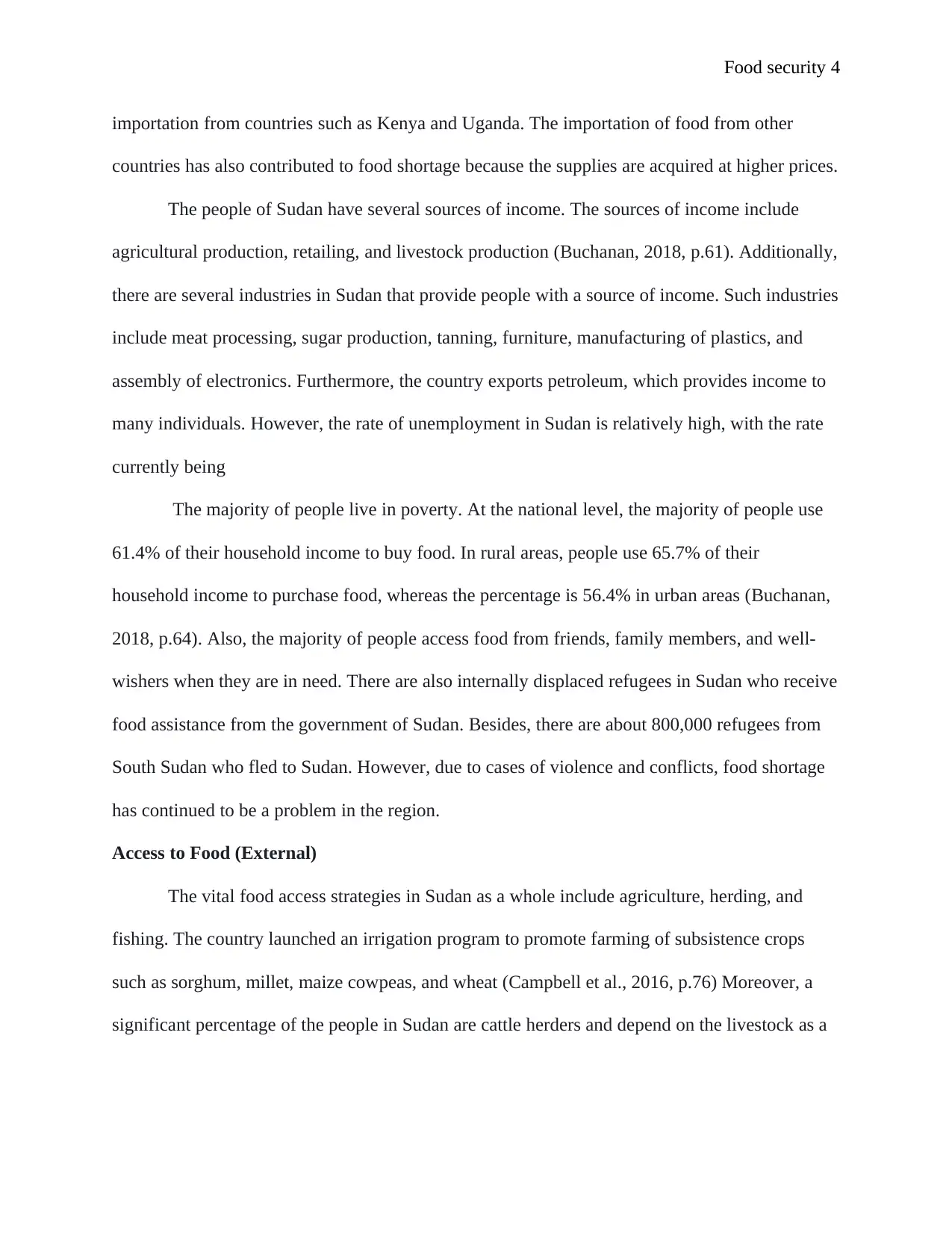
Food security 4
importation from countries such as Kenya and Uganda. The importation of food from other
countries has also contributed to food shortage because the supplies are acquired at higher prices.
The people of Sudan have several sources of income. The sources of income include
agricultural production, retailing, and livestock production (Buchanan, 2018, p.61). Additionally,
there are several industries in Sudan that provide people with a source of income. Such industries
include meat processing, sugar production, tanning, furniture, manufacturing of plastics, and
assembly of electronics. Furthermore, the country exports petroleum, which provides income to
many individuals. However, the rate of unemployment in Sudan is relatively high, with the rate
currently being
The majority of people live in poverty. At the national level, the majority of people use
61.4% of their household income to buy food. In rural areas, people use 65.7% of their
household income to purchase food, whereas the percentage is 56.4% in urban areas (Buchanan,
2018, p.64). Also, the majority of people access food from friends, family members, and well-
wishers when they are in need. There are also internally displaced refugees in Sudan who receive
food assistance from the government of Sudan. Besides, there are about 800,000 refugees from
South Sudan who fled to Sudan. However, due to cases of violence and conflicts, food shortage
has continued to be a problem in the region.
Access to Food (External)
The vital food access strategies in Sudan as a whole include agriculture, herding, and
fishing. The country launched an irrigation program to promote farming of subsistence crops
such as sorghum, millet, maize cowpeas, and wheat (Campbell et al., 2016, p.76) Moreover, a
significant percentage of the people in Sudan are cattle herders and depend on the livestock as a
importation from countries such as Kenya and Uganda. The importation of food from other
countries has also contributed to food shortage because the supplies are acquired at higher prices.
The people of Sudan have several sources of income. The sources of income include
agricultural production, retailing, and livestock production (Buchanan, 2018, p.61). Additionally,
there are several industries in Sudan that provide people with a source of income. Such industries
include meat processing, sugar production, tanning, furniture, manufacturing of plastics, and
assembly of electronics. Furthermore, the country exports petroleum, which provides income to
many individuals. However, the rate of unemployment in Sudan is relatively high, with the rate
currently being
The majority of people live in poverty. At the national level, the majority of people use
61.4% of their household income to buy food. In rural areas, people use 65.7% of their
household income to purchase food, whereas the percentage is 56.4% in urban areas (Buchanan,
2018, p.64). Also, the majority of people access food from friends, family members, and well-
wishers when they are in need. There are also internally displaced refugees in Sudan who receive
food assistance from the government of Sudan. Besides, there are about 800,000 refugees from
South Sudan who fled to Sudan. However, due to cases of violence and conflicts, food shortage
has continued to be a problem in the region.
Access to Food (External)
The vital food access strategies in Sudan as a whole include agriculture, herding, and
fishing. The country launched an irrigation program to promote farming of subsistence crops
such as sorghum, millet, maize cowpeas, and wheat (Campbell et al., 2016, p.76) Moreover, a
significant percentage of the people in Sudan are cattle herders and depend on the livestock as a
Paraphrase This Document
Need a fresh take? Get an instant paraphrase of this document with our AI Paraphraser
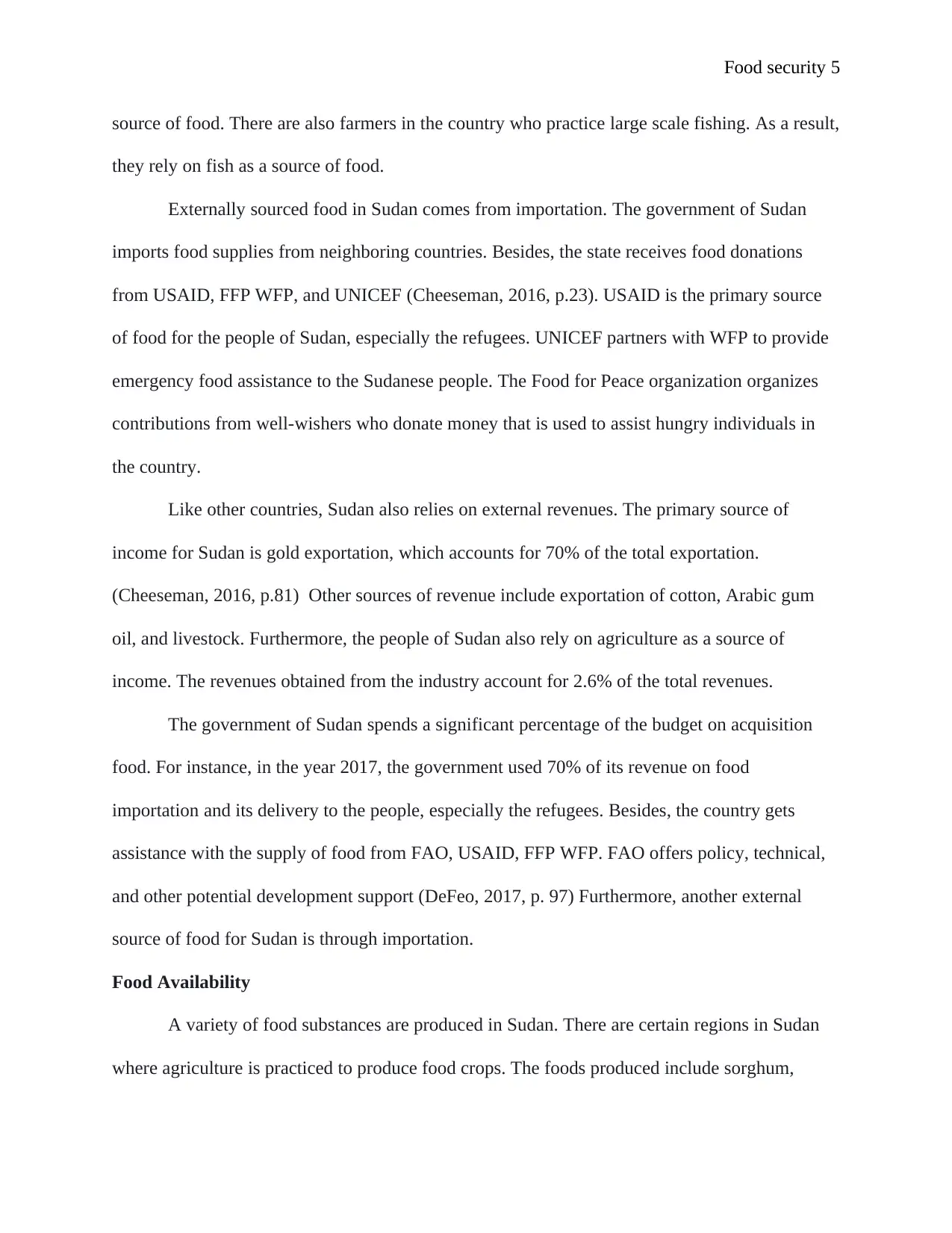
Food security 5
source of food. There are also farmers in the country who practice large scale fishing. As a result,
they rely on fish as a source of food.
Externally sourced food in Sudan comes from importation. The government of Sudan
imports food supplies from neighboring countries. Besides, the state receives food donations
from USAID, FFP WFP, and UNICEF (Cheeseman, 2016, p.23). USAID is the primary source
of food for the people of Sudan, especially the refugees. UNICEF partners with WFP to provide
emergency food assistance to the Sudanese people. The Food for Peace organization organizes
contributions from well-wishers who donate money that is used to assist hungry individuals in
the country.
Like other countries, Sudan also relies on external revenues. The primary source of
income for Sudan is gold exportation, which accounts for 70% of the total exportation.
(Cheeseman, 2016, p.81) Other sources of revenue include exportation of cotton, Arabic gum
oil, and livestock. Furthermore, the people of Sudan also rely on agriculture as a source of
income. The revenues obtained from the industry account for 2.6% of the total revenues.
The government of Sudan spends a significant percentage of the budget on acquisition
food. For instance, in the year 2017, the government used 70% of its revenue on food
importation and its delivery to the people, especially the refugees. Besides, the country gets
assistance with the supply of food from FAO, USAID, FFP WFP. FAO offers policy, technical,
and other potential development support (DeFeo, 2017, p. 97) Furthermore, another external
source of food for Sudan is through importation.
Food Availability
A variety of food substances are produced in Sudan. There are certain regions in Sudan
where agriculture is practiced to produce food crops. The foods produced include sorghum,
source of food. There are also farmers in the country who practice large scale fishing. As a result,
they rely on fish as a source of food.
Externally sourced food in Sudan comes from importation. The government of Sudan
imports food supplies from neighboring countries. Besides, the state receives food donations
from USAID, FFP WFP, and UNICEF (Cheeseman, 2016, p.23). USAID is the primary source
of food for the people of Sudan, especially the refugees. UNICEF partners with WFP to provide
emergency food assistance to the Sudanese people. The Food for Peace organization organizes
contributions from well-wishers who donate money that is used to assist hungry individuals in
the country.
Like other countries, Sudan also relies on external revenues. The primary source of
income for Sudan is gold exportation, which accounts for 70% of the total exportation.
(Cheeseman, 2016, p.81) Other sources of revenue include exportation of cotton, Arabic gum
oil, and livestock. Furthermore, the people of Sudan also rely on agriculture as a source of
income. The revenues obtained from the industry account for 2.6% of the total revenues.
The government of Sudan spends a significant percentage of the budget on acquisition
food. For instance, in the year 2017, the government used 70% of its revenue on food
importation and its delivery to the people, especially the refugees. Besides, the country gets
assistance with the supply of food from FAO, USAID, FFP WFP. FAO offers policy, technical,
and other potential development support (DeFeo, 2017, p. 97) Furthermore, another external
source of food for Sudan is through importation.
Food Availability
A variety of food substances are produced in Sudan. There are certain regions in Sudan
where agriculture is practiced to produce food crops. The foods produced include sorghum,
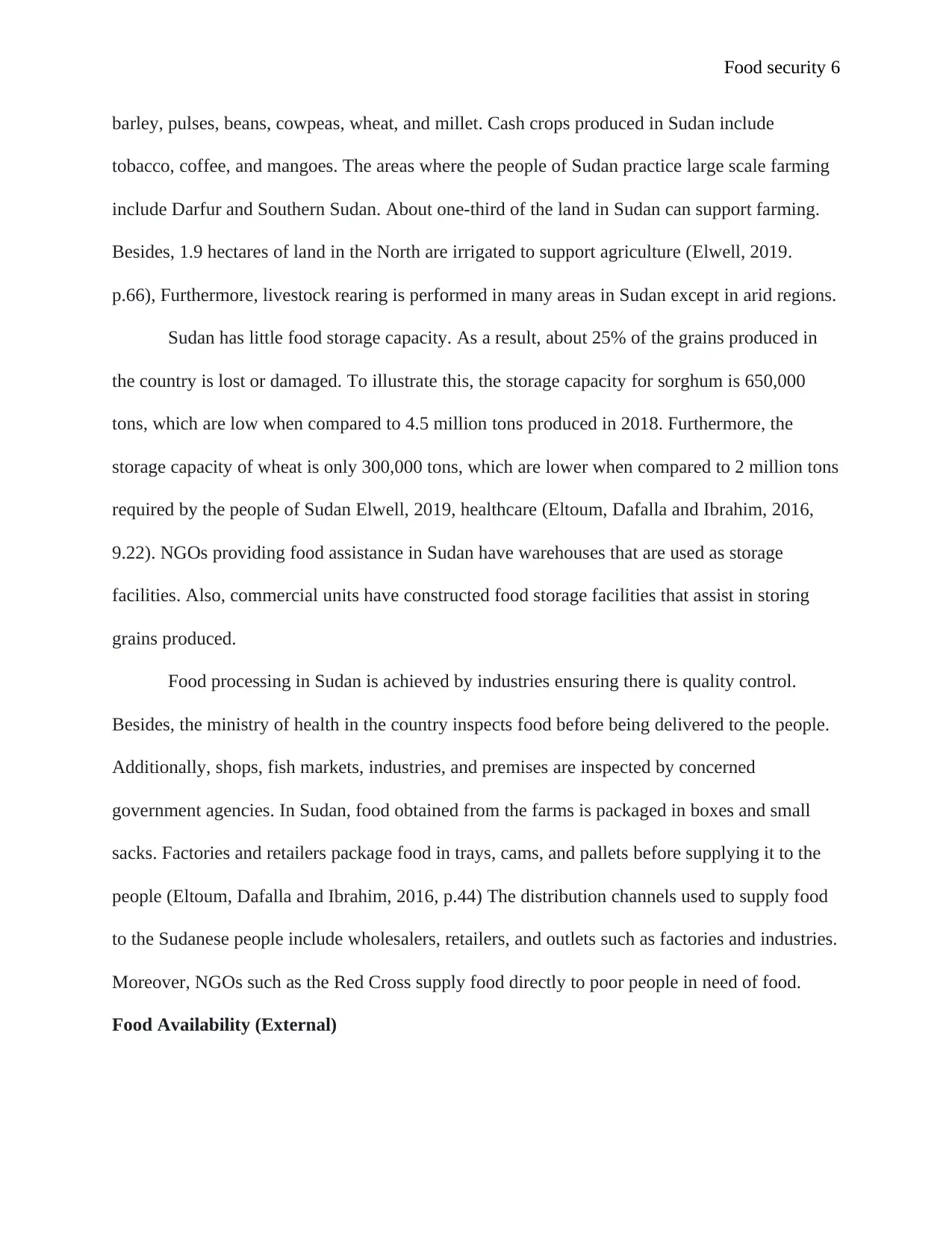
Food security 6
barley, pulses, beans, cowpeas, wheat, and millet. Cash crops produced in Sudan include
tobacco, coffee, and mangoes. The areas where the people of Sudan practice large scale farming
include Darfur and Southern Sudan. About one-third of the land in Sudan can support farming.
Besides, 1.9 hectares of land in the North are irrigated to support agriculture (Elwell, 2019.
p.66), Furthermore, livestock rearing is performed in many areas in Sudan except in arid regions.
Sudan has little food storage capacity. As a result, about 25% of the grains produced in
the country is lost or damaged. To illustrate this, the storage capacity for sorghum is 650,000
tons, which are low when compared to 4.5 million tons produced in 2018. Furthermore, the
storage capacity of wheat is only 300,000 tons, which are lower when compared to 2 million tons
required by the people of Sudan Elwell, 2019, healthcare (Eltoum, Dafalla and Ibrahim, 2016,
9.22). NGOs providing food assistance in Sudan have warehouses that are used as storage
facilities. Also, commercial units have constructed food storage facilities that assist in storing
grains produced.
Food processing in Sudan is achieved by industries ensuring there is quality control.
Besides, the ministry of health in the country inspects food before being delivered to the people.
Additionally, shops, fish markets, industries, and premises are inspected by concerned
government agencies. In Sudan, food obtained from the farms is packaged in boxes and small
sacks. Factories and retailers package food in trays, cams, and pallets before supplying it to the
people (Eltoum, Dafalla and Ibrahim, 2016, p.44) The distribution channels used to supply food
to the Sudanese people include wholesalers, retailers, and outlets such as factories and industries.
Moreover, NGOs such as the Red Cross supply food directly to poor people in need of food.
Food Availability (External)
barley, pulses, beans, cowpeas, wheat, and millet. Cash crops produced in Sudan include
tobacco, coffee, and mangoes. The areas where the people of Sudan practice large scale farming
include Darfur and Southern Sudan. About one-third of the land in Sudan can support farming.
Besides, 1.9 hectares of land in the North are irrigated to support agriculture (Elwell, 2019.
p.66), Furthermore, livestock rearing is performed in many areas in Sudan except in arid regions.
Sudan has little food storage capacity. As a result, about 25% of the grains produced in
the country is lost or damaged. To illustrate this, the storage capacity for sorghum is 650,000
tons, which are low when compared to 4.5 million tons produced in 2018. Furthermore, the
storage capacity of wheat is only 300,000 tons, which are lower when compared to 2 million tons
required by the people of Sudan Elwell, 2019, healthcare (Eltoum, Dafalla and Ibrahim, 2016,
9.22). NGOs providing food assistance in Sudan have warehouses that are used as storage
facilities. Also, commercial units have constructed food storage facilities that assist in storing
grains produced.
Food processing in Sudan is achieved by industries ensuring there is quality control.
Besides, the ministry of health in the country inspects food before being delivered to the people.
Additionally, shops, fish markets, industries, and premises are inspected by concerned
government agencies. In Sudan, food obtained from the farms is packaged in boxes and small
sacks. Factories and retailers package food in trays, cams, and pallets before supplying it to the
people (Eltoum, Dafalla and Ibrahim, 2016, p.44) The distribution channels used to supply food
to the Sudanese people include wholesalers, retailers, and outlets such as factories and industries.
Moreover, NGOs such as the Red Cross supply food directly to poor people in need of food.
Food Availability (External)
⊘ This is a preview!⊘
Do you want full access?
Subscribe today to unlock all pages.

Trusted by 1+ million students worldwide
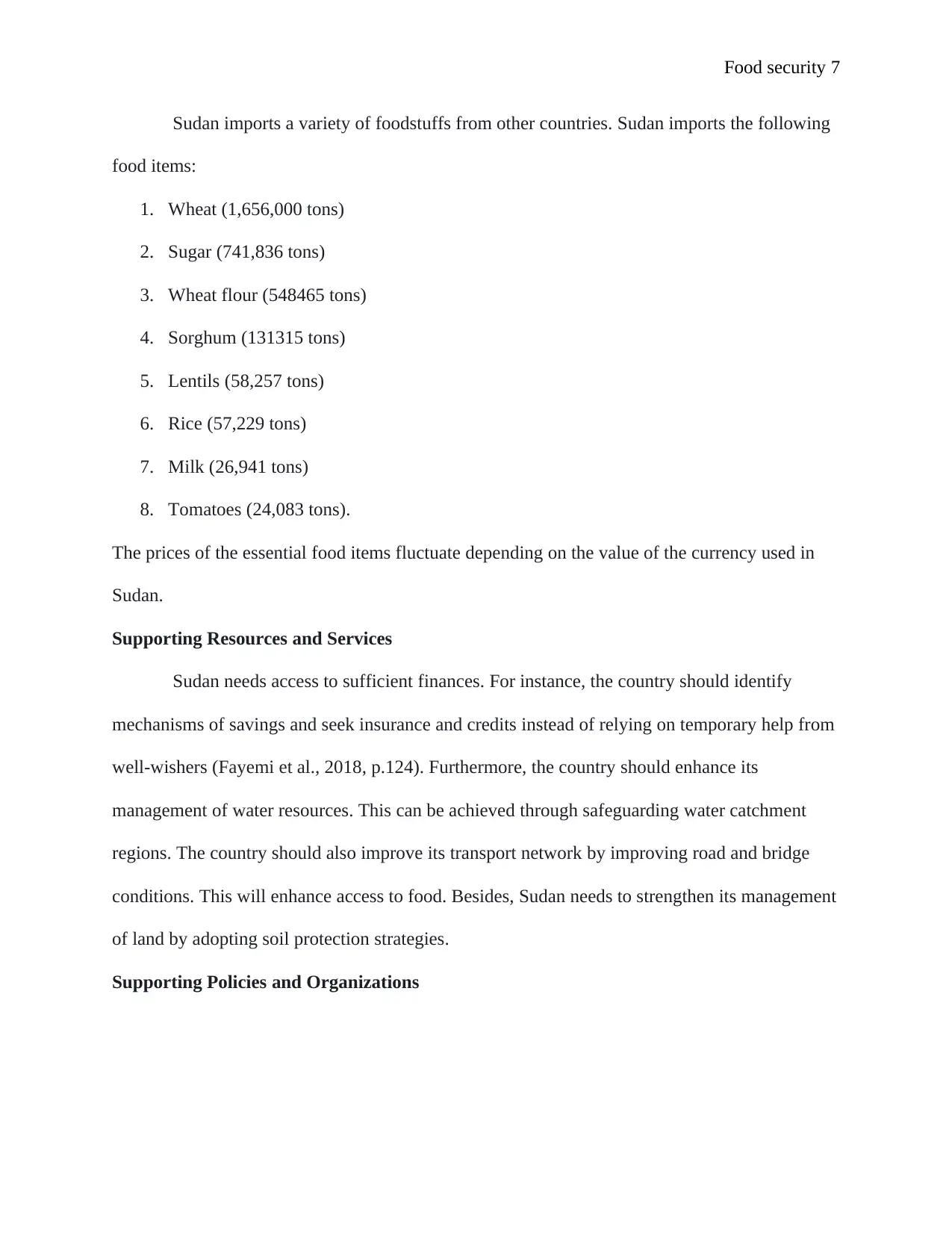
Food security 7
Sudan imports a variety of foodstuffs from other countries. Sudan imports the following
food items:
1. Wheat (1,656,000 tons)
2. Sugar (741,836 tons)
3. Wheat flour (548465 tons)
4. Sorghum (131315 tons)
5. Lentils (58,257 tons)
6. Rice (57,229 tons)
7. Milk (26,941 tons)
8. Tomatoes (24,083 tons).
The prices of the essential food items fluctuate depending on the value of the currency used in
Sudan.
Supporting Resources and Services
Sudan needs access to sufficient finances. For instance, the country should identify
mechanisms of savings and seek insurance and credits instead of relying on temporary help from
well-wishers (Fayemi et al., 2018, p.124). Furthermore, the country should enhance its
management of water resources. This can be achieved through safeguarding water catchment
regions. The country should also improve its transport network by improving road and bridge
conditions. This will enhance access to food. Besides, Sudan needs to strengthen its management
of land by adopting soil protection strategies.
Supporting Policies and Organizations
Sudan imports a variety of foodstuffs from other countries. Sudan imports the following
food items:
1. Wheat (1,656,000 tons)
2. Sugar (741,836 tons)
3. Wheat flour (548465 tons)
4. Sorghum (131315 tons)
5. Lentils (58,257 tons)
6. Rice (57,229 tons)
7. Milk (26,941 tons)
8. Tomatoes (24,083 tons).
The prices of the essential food items fluctuate depending on the value of the currency used in
Sudan.
Supporting Resources and Services
Sudan needs access to sufficient finances. For instance, the country should identify
mechanisms of savings and seek insurance and credits instead of relying on temporary help from
well-wishers (Fayemi et al., 2018, p.124). Furthermore, the country should enhance its
management of water resources. This can be achieved through safeguarding water catchment
regions. The country should also improve its transport network by improving road and bridge
conditions. This will enhance access to food. Besides, Sudan needs to strengthen its management
of land by adopting soil protection strategies.
Supporting Policies and Organizations
Paraphrase This Document
Need a fresh take? Get an instant paraphrase of this document with our AI Paraphraser
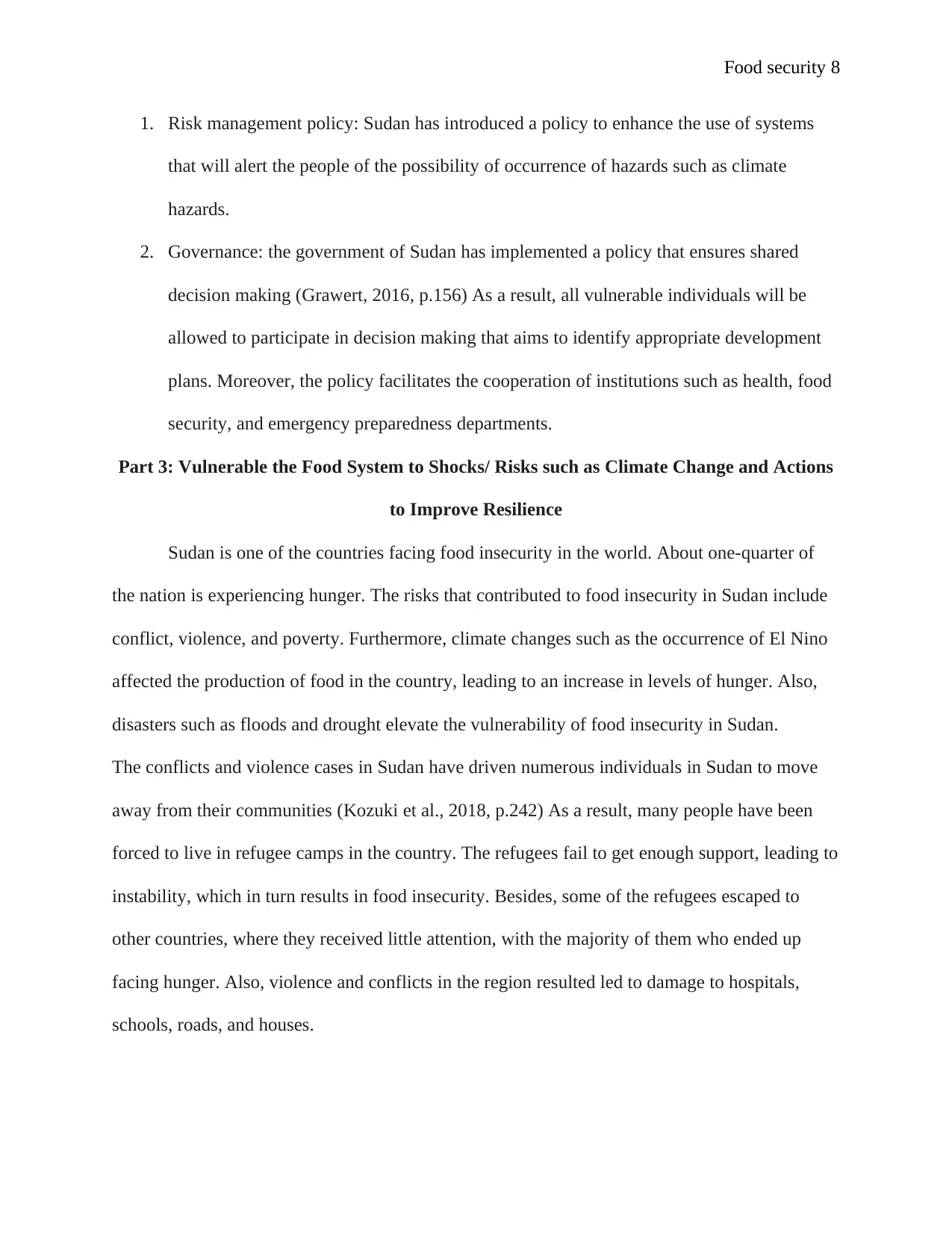
Food security 8
1. Risk management policy: Sudan has introduced a policy to enhance the use of systems
that will alert the people of the possibility of occurrence of hazards such as climate
hazards.
2. Governance: the government of Sudan has implemented a policy that ensures shared
decision making (Grawert, 2016, p.156) As a result, all vulnerable individuals will be
allowed to participate in decision making that aims to identify appropriate development
plans. Moreover, the policy facilitates the cooperation of institutions such as health, food
security, and emergency preparedness departments.
Part 3: Vulnerable the Food System to Shocks/ Risks such as Climate Change and Actions
to Improve Resilience
Sudan is one of the countries facing food insecurity in the world. About one-quarter of
the nation is experiencing hunger. The risks that contributed to food insecurity in Sudan include
conflict, violence, and poverty. Furthermore, climate changes such as the occurrence of El Nino
affected the production of food in the country, leading to an increase in levels of hunger. Also,
disasters such as floods and drought elevate the vulnerability of food insecurity in Sudan.
The conflicts and violence cases in Sudan have driven numerous individuals in Sudan to move
away from their communities (Kozuki et al., 2018, p.242) As a result, many people have been
forced to live in refugee camps in the country. The refugees fail to get enough support, leading to
instability, which in turn results in food insecurity. Besides, some of the refugees escaped to
other countries, where they received little attention, with the majority of them who ended up
facing hunger. Also, violence and conflicts in the region resulted led to damage to hospitals,
schools, roads, and houses.
1. Risk management policy: Sudan has introduced a policy to enhance the use of systems
that will alert the people of the possibility of occurrence of hazards such as climate
hazards.
2. Governance: the government of Sudan has implemented a policy that ensures shared
decision making (Grawert, 2016, p.156) As a result, all vulnerable individuals will be
allowed to participate in decision making that aims to identify appropriate development
plans. Moreover, the policy facilitates the cooperation of institutions such as health, food
security, and emergency preparedness departments.
Part 3: Vulnerable the Food System to Shocks/ Risks such as Climate Change and Actions
to Improve Resilience
Sudan is one of the countries facing food insecurity in the world. About one-quarter of
the nation is experiencing hunger. The risks that contributed to food insecurity in Sudan include
conflict, violence, and poverty. Furthermore, climate changes such as the occurrence of El Nino
affected the production of food in the country, leading to an increase in levels of hunger. Also,
disasters such as floods and drought elevate the vulnerability of food insecurity in Sudan.
The conflicts and violence cases in Sudan have driven numerous individuals in Sudan to move
away from their communities (Kozuki et al., 2018, p.242) As a result, many people have been
forced to live in refugee camps in the country. The refugees fail to get enough support, leading to
instability, which in turn results in food insecurity. Besides, some of the refugees escaped to
other countries, where they received little attention, with the majority of them who ended up
facing hunger. Also, violence and conflicts in the region resulted led to damage to hospitals,
schools, roads, and houses.
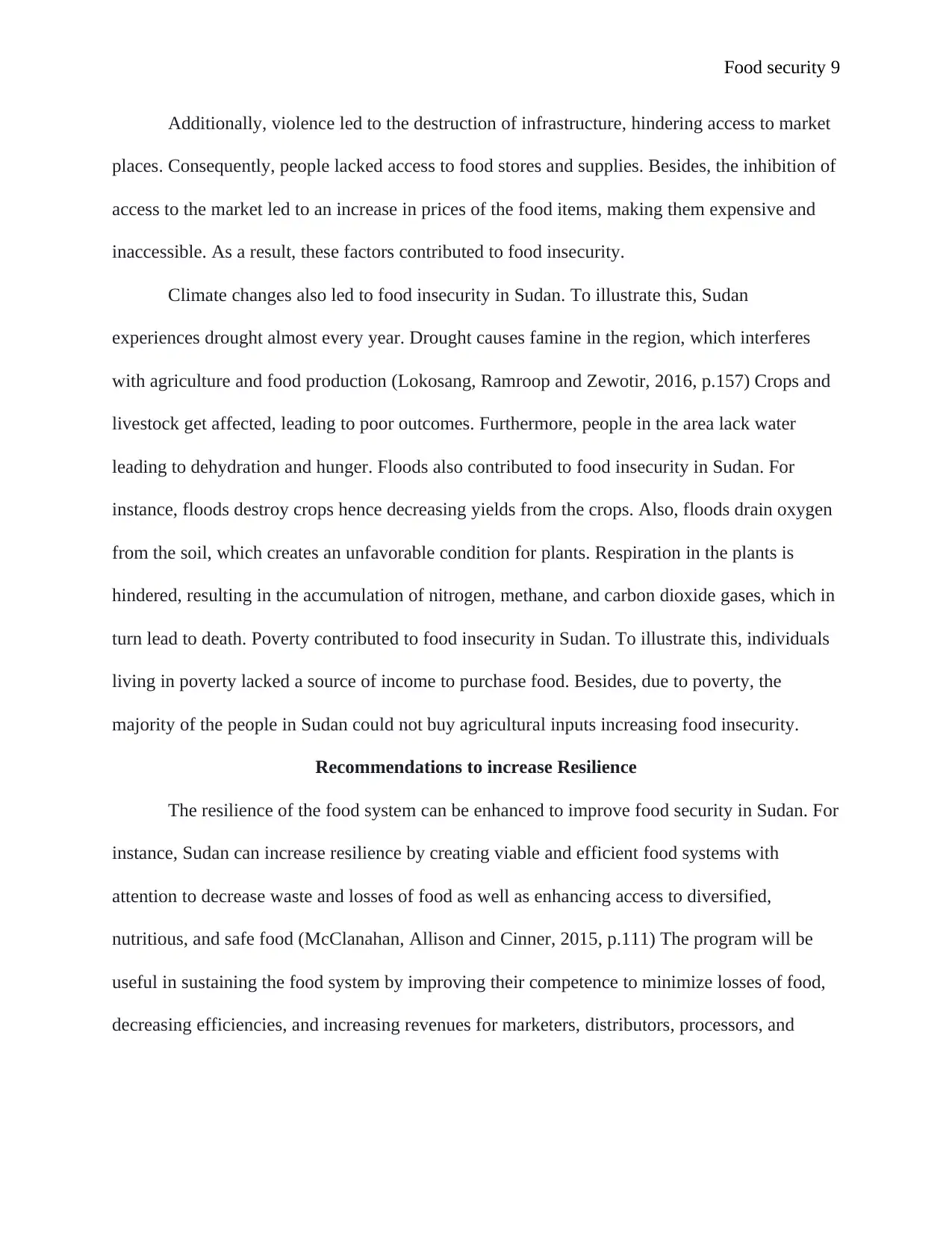
Food security 9
Additionally, violence led to the destruction of infrastructure, hindering access to market
places. Consequently, people lacked access to food stores and supplies. Besides, the inhibition of
access to the market led to an increase in prices of the food items, making them expensive and
inaccessible. As a result, these factors contributed to food insecurity.
Climate changes also led to food insecurity in Sudan. To illustrate this, Sudan
experiences drought almost every year. Drought causes famine in the region, which interferes
with agriculture and food production (Lokosang, Ramroop and Zewotir, 2016, p.157) Crops and
livestock get affected, leading to poor outcomes. Furthermore, people in the area lack water
leading to dehydration and hunger. Floods also contributed to food insecurity in Sudan. For
instance, floods destroy crops hence decreasing yields from the crops. Also, floods drain oxygen
from the soil, which creates an unfavorable condition for plants. Respiration in the plants is
hindered, resulting in the accumulation of nitrogen, methane, and carbon dioxide gases, which in
turn lead to death. Poverty contributed to food insecurity in Sudan. To illustrate this, individuals
living in poverty lacked a source of income to purchase food. Besides, due to poverty, the
majority of the people in Sudan could not buy agricultural inputs increasing food insecurity.
Recommendations to increase Resilience
The resilience of the food system can be enhanced to improve food security in Sudan. For
instance, Sudan can increase resilience by creating viable and efficient food systems with
attention to decrease waste and losses of food as well as enhancing access to diversified,
nutritious, and safe food (McClanahan, Allison and Cinner, 2015, p.111) The program will be
useful in sustaining the food system by improving their competence to minimize losses of food,
decreasing efficiencies, and increasing revenues for marketers, distributors, processors, and
Additionally, violence led to the destruction of infrastructure, hindering access to market
places. Consequently, people lacked access to food stores and supplies. Besides, the inhibition of
access to the market led to an increase in prices of the food items, making them expensive and
inaccessible. As a result, these factors contributed to food insecurity.
Climate changes also led to food insecurity in Sudan. To illustrate this, Sudan
experiences drought almost every year. Drought causes famine in the region, which interferes
with agriculture and food production (Lokosang, Ramroop and Zewotir, 2016, p.157) Crops and
livestock get affected, leading to poor outcomes. Furthermore, people in the area lack water
leading to dehydration and hunger. Floods also contributed to food insecurity in Sudan. For
instance, floods destroy crops hence decreasing yields from the crops. Also, floods drain oxygen
from the soil, which creates an unfavorable condition for plants. Respiration in the plants is
hindered, resulting in the accumulation of nitrogen, methane, and carbon dioxide gases, which in
turn lead to death. Poverty contributed to food insecurity in Sudan. To illustrate this, individuals
living in poverty lacked a source of income to purchase food. Besides, due to poverty, the
majority of the people in Sudan could not buy agricultural inputs increasing food insecurity.
Recommendations to increase Resilience
The resilience of the food system can be enhanced to improve food security in Sudan. For
instance, Sudan can increase resilience by creating viable and efficient food systems with
attention to decrease waste and losses of food as well as enhancing access to diversified,
nutritious, and safe food (McClanahan, Allison and Cinner, 2015, p.111) The program will be
useful in sustaining the food system by improving their competence to minimize losses of food,
decreasing efficiencies, and increasing revenues for marketers, distributors, processors, and
⊘ This is a preview!⊘
Do you want full access?
Subscribe today to unlock all pages.

Trusted by 1+ million students worldwide
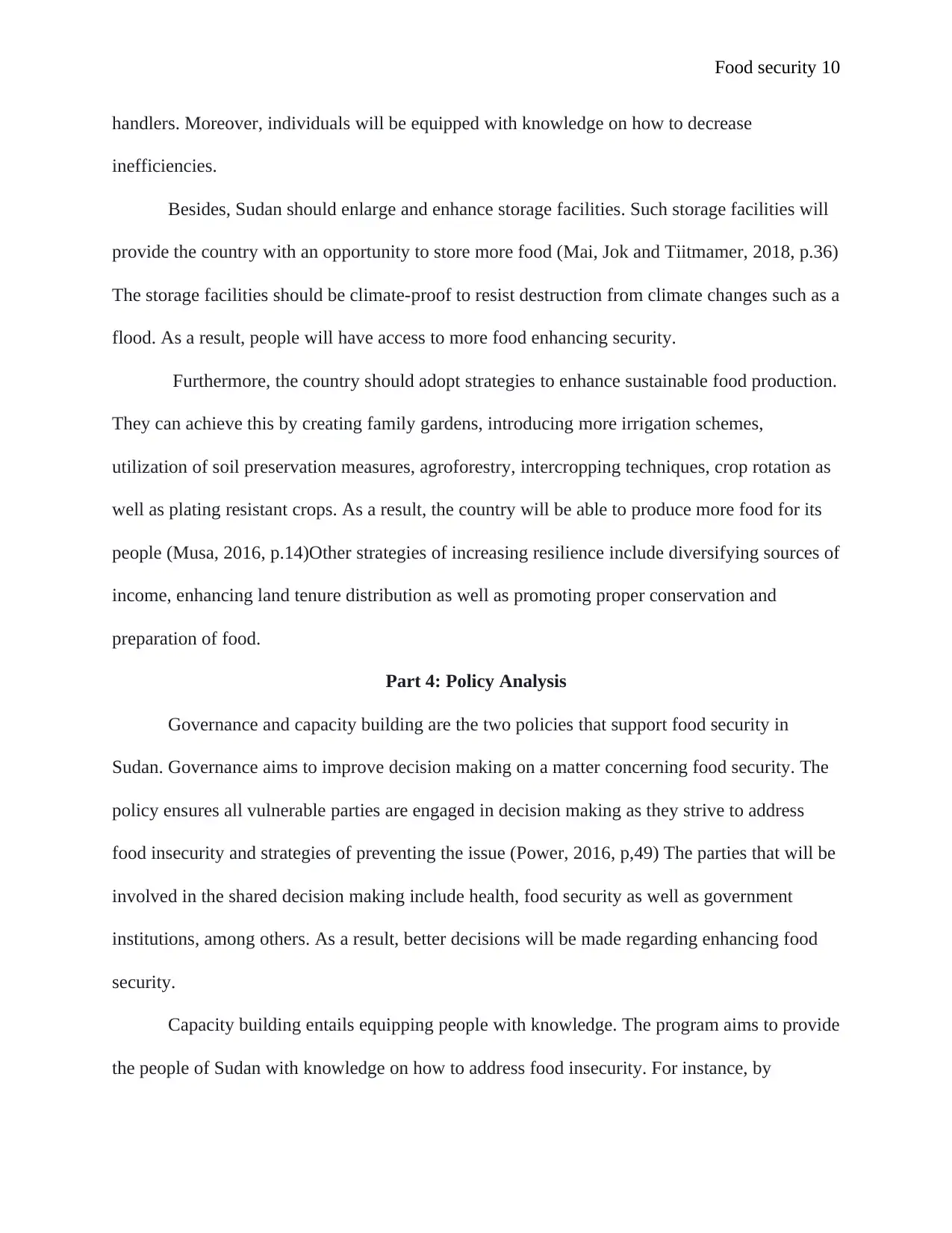
Food security 10
handlers. Moreover, individuals will be equipped with knowledge on how to decrease
inefficiencies.
Besides, Sudan should enlarge and enhance storage facilities. Such storage facilities will
provide the country with an opportunity to store more food (Mai, Jok and Tiitmamer, 2018, p.36)
The storage facilities should be climate-proof to resist destruction from climate changes such as a
flood. As a result, people will have access to more food enhancing security.
Furthermore, the country should adopt strategies to enhance sustainable food production.
They can achieve this by creating family gardens, introducing more irrigation schemes,
utilization of soil preservation measures, agroforestry, intercropping techniques, crop rotation as
well as plating resistant crops. As a result, the country will be able to produce more food for its
people (Musa, 2016, p.14)Other strategies of increasing resilience include diversifying sources of
income, enhancing land tenure distribution as well as promoting proper conservation and
preparation of food.
Part 4: Policy Analysis
Governance and capacity building are the two policies that support food security in
Sudan. Governance aims to improve decision making on a matter concerning food security. The
policy ensures all vulnerable parties are engaged in decision making as they strive to address
food insecurity and strategies of preventing the issue (Power, 2016, p,49) The parties that will be
involved in the shared decision making include health, food security as well as government
institutions, among others. As a result, better decisions will be made regarding enhancing food
security.
Capacity building entails equipping people with knowledge. The program aims to provide
the people of Sudan with knowledge on how to address food insecurity. For instance, by
handlers. Moreover, individuals will be equipped with knowledge on how to decrease
inefficiencies.
Besides, Sudan should enlarge and enhance storage facilities. Such storage facilities will
provide the country with an opportunity to store more food (Mai, Jok and Tiitmamer, 2018, p.36)
The storage facilities should be climate-proof to resist destruction from climate changes such as a
flood. As a result, people will have access to more food enhancing security.
Furthermore, the country should adopt strategies to enhance sustainable food production.
They can achieve this by creating family gardens, introducing more irrigation schemes,
utilization of soil preservation measures, agroforestry, intercropping techniques, crop rotation as
well as plating resistant crops. As a result, the country will be able to produce more food for its
people (Musa, 2016, p.14)Other strategies of increasing resilience include diversifying sources of
income, enhancing land tenure distribution as well as promoting proper conservation and
preparation of food.
Part 4: Policy Analysis
Governance and capacity building are the two policies that support food security in
Sudan. Governance aims to improve decision making on a matter concerning food security. The
policy ensures all vulnerable parties are engaged in decision making as they strive to address
food insecurity and strategies of preventing the issue (Power, 2016, p,49) The parties that will be
involved in the shared decision making include health, food security as well as government
institutions, among others. As a result, better decisions will be made regarding enhancing food
security.
Capacity building entails equipping people with knowledge. The program aims to provide
the people of Sudan with knowledge on how to address food insecurity. For instance, by
Paraphrase This Document
Need a fresh take? Get an instant paraphrase of this document with our AI Paraphraser
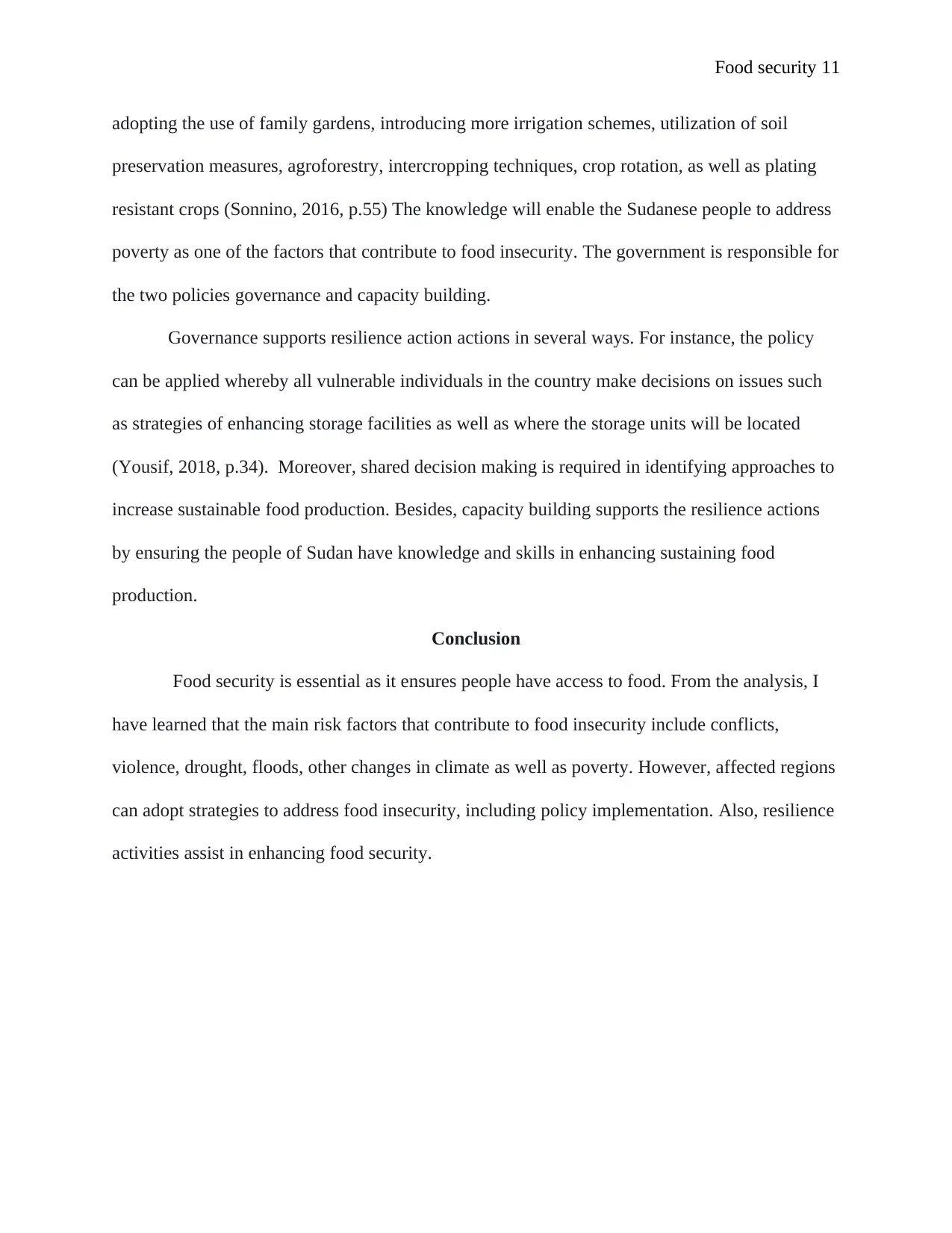
Food security 11
adopting the use of family gardens, introducing more irrigation schemes, utilization of soil
preservation measures, agroforestry, intercropping techniques, crop rotation, as well as plating
resistant crops (Sonnino, 2016, p.55) The knowledge will enable the Sudanese people to address
poverty as one of the factors that contribute to food insecurity. The government is responsible for
the two policies governance and capacity building.
Governance supports resilience action actions in several ways. For instance, the policy
can be applied whereby all vulnerable individuals in the country make decisions on issues such
as strategies of enhancing storage facilities as well as where the storage units will be located
(Yousif, 2018, p.34). Moreover, shared decision making is required in identifying approaches to
increase sustainable food production. Besides, capacity building supports the resilience actions
by ensuring the people of Sudan have knowledge and skills in enhancing sustaining food
production.
Conclusion
Food security is essential as it ensures people have access to food. From the analysis, I
have learned that the main risk factors that contribute to food insecurity include conflicts,
violence, drought, floods, other changes in climate as well as poverty. However, affected regions
can adopt strategies to address food insecurity, including policy implementation. Also, resilience
activities assist in enhancing food security.
adopting the use of family gardens, introducing more irrigation schemes, utilization of soil
preservation measures, agroforestry, intercropping techniques, crop rotation, as well as plating
resistant crops (Sonnino, 2016, p.55) The knowledge will enable the Sudanese people to address
poverty as one of the factors that contribute to food insecurity. The government is responsible for
the two policies governance and capacity building.
Governance supports resilience action actions in several ways. For instance, the policy
can be applied whereby all vulnerable individuals in the country make decisions on issues such
as strategies of enhancing storage facilities as well as where the storage units will be located
(Yousif, 2018, p.34). Moreover, shared decision making is required in identifying approaches to
increase sustainable food production. Besides, capacity building supports the resilience actions
by ensuring the people of Sudan have knowledge and skills in enhancing sustaining food
production.
Conclusion
Food security is essential as it ensures people have access to food. From the analysis, I
have learned that the main risk factors that contribute to food insecurity include conflicts,
violence, drought, floods, other changes in climate as well as poverty. However, affected regions
can adopt strategies to address food insecurity, including policy implementation. Also, resilience
activities assist in enhancing food security.
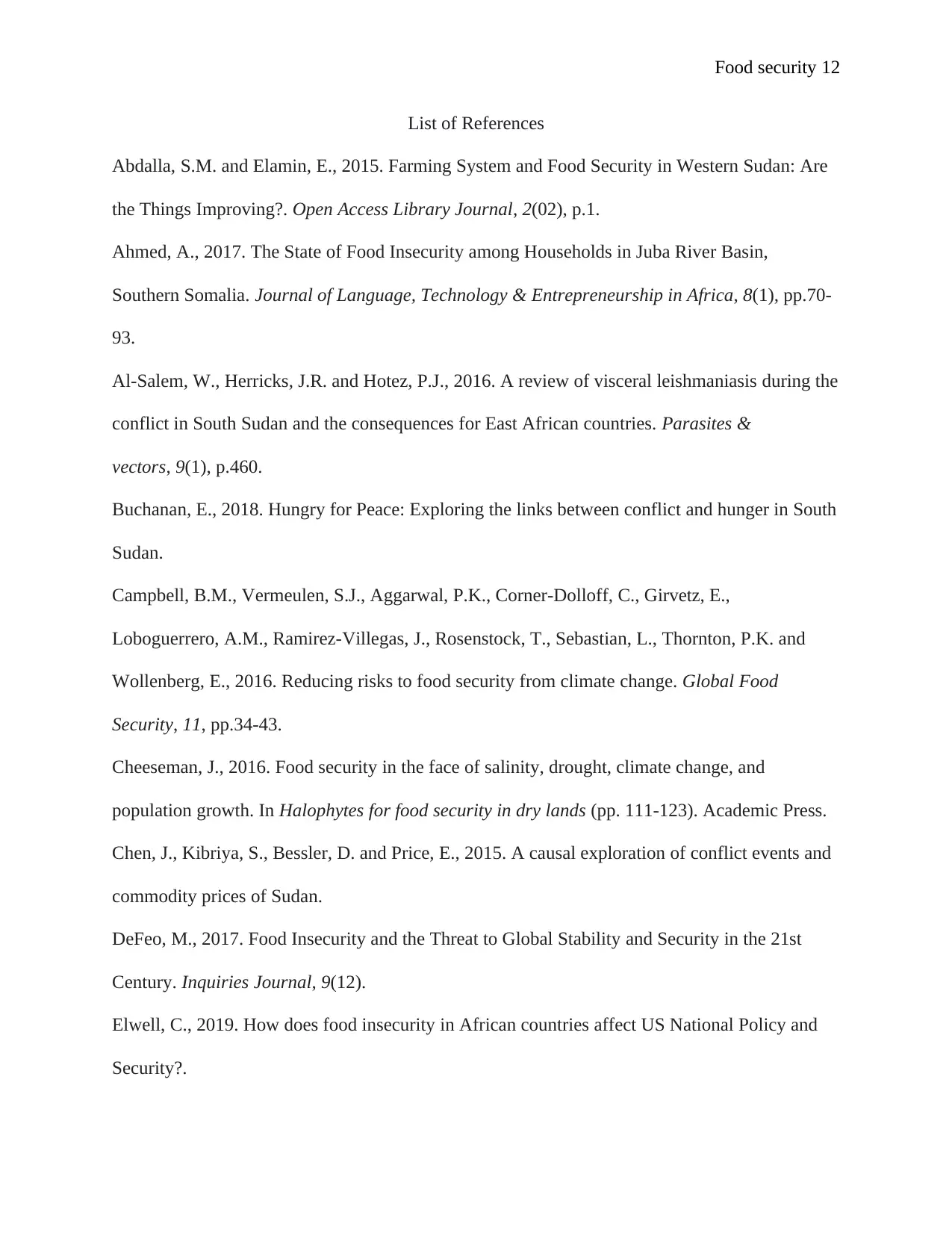
Food security 12
List of References
Abdalla, S.M. and Elamin, E., 2015. Farming System and Food Security in Western Sudan: Are
the Things Improving?. Open Access Library Journal, 2(02), p.1.
Ahmed, A., 2017. The State of Food Insecurity among Households in Juba River Basin,
Southern Somalia. Journal of Language, Technology & Entrepreneurship in Africa, 8(1), pp.70-
93.
Al-Salem, W., Herricks, J.R. and Hotez, P.J., 2016. A review of visceral leishmaniasis during the
conflict in South Sudan and the consequences for East African countries. Parasites &
vectors, 9(1), p.460.
Buchanan, E., 2018. Hungry for Peace: Exploring the links between conflict and hunger in South
Sudan.
Campbell, B.M., Vermeulen, S.J., Aggarwal, P.K., Corner-Dolloff, C., Girvetz, E.,
Loboguerrero, A.M., Ramirez-Villegas, J., Rosenstock, T., Sebastian, L., Thornton, P.K. and
Wollenberg, E., 2016. Reducing risks to food security from climate change. Global Food
Security, 11, pp.34-43.
Cheeseman, J., 2016. Food security in the face of salinity, drought, climate change, and
population growth. In Halophytes for food security in dry lands (pp. 111-123). Academic Press.
Chen, J., Kibriya, S., Bessler, D. and Price, E., 2015. A causal exploration of conflict events and
commodity prices of Sudan.
DeFeo, M., 2017. Food Insecurity and the Threat to Global Stability and Security in the 21st
Century. Inquiries Journal, 9(12).
Elwell, C., 2019. How does food insecurity in African countries affect US National Policy and
Security?.
List of References
Abdalla, S.M. and Elamin, E., 2015. Farming System and Food Security in Western Sudan: Are
the Things Improving?. Open Access Library Journal, 2(02), p.1.
Ahmed, A., 2017. The State of Food Insecurity among Households in Juba River Basin,
Southern Somalia. Journal of Language, Technology & Entrepreneurship in Africa, 8(1), pp.70-
93.
Al-Salem, W., Herricks, J.R. and Hotez, P.J., 2016. A review of visceral leishmaniasis during the
conflict in South Sudan and the consequences for East African countries. Parasites &
vectors, 9(1), p.460.
Buchanan, E., 2018. Hungry for Peace: Exploring the links between conflict and hunger in South
Sudan.
Campbell, B.M., Vermeulen, S.J., Aggarwal, P.K., Corner-Dolloff, C., Girvetz, E.,
Loboguerrero, A.M., Ramirez-Villegas, J., Rosenstock, T., Sebastian, L., Thornton, P.K. and
Wollenberg, E., 2016. Reducing risks to food security from climate change. Global Food
Security, 11, pp.34-43.
Cheeseman, J., 2016. Food security in the face of salinity, drought, climate change, and
population growth. In Halophytes for food security in dry lands (pp. 111-123). Academic Press.
Chen, J., Kibriya, S., Bessler, D. and Price, E., 2015. A causal exploration of conflict events and
commodity prices of Sudan.
DeFeo, M., 2017. Food Insecurity and the Threat to Global Stability and Security in the 21st
Century. Inquiries Journal, 9(12).
Elwell, C., 2019. How does food insecurity in African countries affect US National Policy and
Security?.
⊘ This is a preview!⊘
Do you want full access?
Subscribe today to unlock all pages.

Trusted by 1+ million students worldwide
1 out of 13
Your All-in-One AI-Powered Toolkit for Academic Success.
+13062052269
info@desklib.com
Available 24*7 on WhatsApp / Email
![[object Object]](/_next/static/media/star-bottom.7253800d.svg)
Unlock your academic potential
Copyright © 2020–2025 A2Z Services. All Rights Reserved. Developed and managed by ZUCOL.